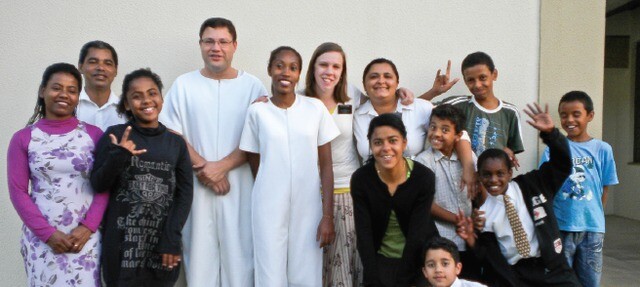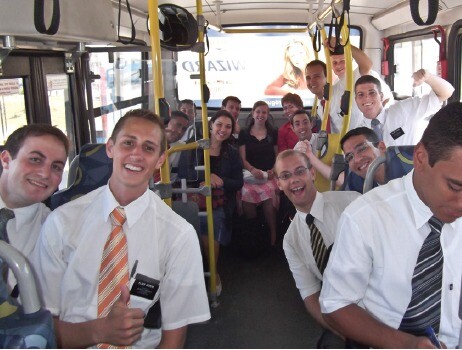
The history of the Church in Brazil actually began in Germany, danke very much. The first known member in the country was Max Richard Zapf, who was baptized in Germany in 1908 and immigrated to Brazil in 1913. After years passed with no Church contact, Zapf learned there was another German LDS family, the Lippelts, living in Brazil. These two families—who became fast friends—represented the beginning of the Church’s permanent presence in the South American country.
In 1927, the first missionaries visited Brazil, and in 1939, a Portuguese edition of the Book of Mormon was published.
The São Paulo Stake—the first in South America—was organized in 1966, and in 1978, the São Paulo Temple was dedicated.
Today, one in 187 Brazilians is LDS, and President Monson announced a temple would be built in Rio de Janeiro at the April 2013 general conference.
Members Welcome
Friendly. Heartfelt. Loving. Welcoming. Ask missionaries who’ve served there what the Brazilian Saints are like, and the answers are consistently cheerful.
“Brazilians are a very happy and loving people, and that shows in the way they take care of each other in the wards,” says Karen Ogden, who served in the Brazil São Paulo East Mission from 2010 to 2011. “One phrase I heard nearly every day for 18 months was, ‘Come mais, Sister! Você não comeu nada!’ It means, ‘Eat more, Sister! You haven’t eaten anything!’ This usually came after two full plates at lunch!”
Ben Davidson, who served in the Brazil São Paulo North Mission from 1998 to 2000, loved how genuine the Saints are. “The Brazilian Latter-day Saints are a truly delightful people; they are loving, caring, and candid,” he says. “Sarcasm doesn’t really exist in Brazil, and the Saints are very sincere.”
That sincerity actually comes from pride (the good kind). “We are valiant and true to what we believe,” says Brazilian member Monica Lunardelli, whose parents joined the Church before she was born. “We are proud to be Mormons and to be different from other people in so many ways.”
What’s more, Saints in Brazil are willing to step up and lead in an area where the Church is still relatively young. “The Church in Brazil is very well organized and motivated to establish Zion,” says Elder Joaquim Jorge Oliveira Moreira, a former mission president of the Brazil São Paulo East Mission and now an Area Seventy for the Church. “Brazilian Saints are happy to live the gospel and are dedicated to establishing Zion in their own families.”
This dedication—without a doubt—leads to faith-filled opportunities. “We have a lot of faith to do the things the Lord asks, and we do it not because of tradition but because the Lord asks us to,” says Renato Araújo, whose parents became members when he was little. “Because of this, our leaders tend to be a lot younger than those in the United States. I, for example, am the Young Men president of my ward, even though I’m only 22.”
And their happy, willing nature has not gone unnoticed by the Brethren.
“As a nation, Brazil is experiencing a period of dramatic growth,” Elder M. Russell Ballard said after visiting Brazil in 2012. “Members of the Church in Brazil will keep pace with that, and many of them will become leaders in industry, education, and politics. The Church is maturing here, and I was impressed with what the Brazilian members are accomplishing both temporally and spiritually. I was particularly pleased to see how many young people continue to accept missionary calls and how many marry in the temple. They are the bright future of the Church. They will continue to build the Church in this marvelous country.”
Mission Possible
As the country with the third largest LDS population of members (behind the United States and Mexico), Brazil is known for its momentous missionary movement. “The Brazilian people are very respectful with our missionaries,” Elder Moreira says. “They have a community culture so amazing, it’s unlike anything I had ever seen before in any other people.”
Davidson couldn’t agree more. “For the most part, Brazilians are happy to discuss and debate the gospel with the missionaries, whether they agree with the message or not,” he says. “They are generous hosts who welcome visitors into their homes. As a result, my calendar was full of appointments on most days, and we rarely knocked on doors as a tracting method.”
But even more powerful than the hospitality of the culture is the faith of the members. “Certainly the friendly culture helps the missionaries get the conversation started,” Davidson says. “Ultimately, the Church has grown because the members have the courage to act on the testimonies they gain.”

And when each of the 35,000 new converts a year comes into the fold, the Saints welcome their new brother or sister with open arms. “We spent more time teaching with the members than by ourselves!” says Ogden, who is actually engaged to Araújo. “I worked with some pretty stellar ward mission leaders who were very involved in getting to know and befriending our investigators—and they encouraged other members to do the same.”
Plus, that missionary focus has led to a testimony focus. “It’s fun to have so many new converts because in classes we try to stick to the basics,” Lunardelli says. “There’s no way you can explain about the pioneers in Nauvoo if people don’t understand who Joseph Smith was, so we always have to reinforce the fundamentals. Nurturing the testimony of those new converts ends up adding to your own testimony.”
In addition to welcoming new converts, the Brazilian Saints make a point of finding them, too. “I met people who didn’t have time to go out and teach with us—and yet they did,” Ogden says. “They were people who’d already brought all their friends to church—and yet they kept bringing more.”
Trials of the Times
The struggles Latter-day Saints face in Brazil largely derive from being a young, minority population. “Members in Brazil are usually the only members at school, work, everywhere!” Lunardelli says. “Even though the Church is growing a lot, many Brazilians still haven’t heard about the Mormons. Being the only member can sometimes be very difficult, especially when you’re young and trying so hard to fit into a group.”
And in a world where international Saints are hungry for information and connection to Church headquarters, the World Wide Web is a worldwide blessing. “We are still learning,” Lunardelli says. “I grew up in the Church, and yet I didn’t know there was such a thing as the General Young Women’s Meeting until I was 16! You can imagine how thankful we are today for the Internet.”
They’re thankful—and mindful. “Like any other part of the world, the advance in technologies and economies can turn us into the type of people who are very distant from one another,” Elder Moreira says. “However, with the foundation of the gospel the members in Brazil have, these challenges are possible to go through. And despite any challenges, they always have a smile on their faces.”
Ultimately, though, our brothers and sisters in Brazil face the same everyday struggles to be steadfast and immovable. “We are not that different from the Church in the U.S.!” Lunardelli says. “We may not have funeral potatoes or green Jell-O in Church activities, but we go to Church dances to find a boyfriend, we love a good fireside, and we struggle sometimes to visit teach. Even though our cultural background may be different, we believe in the same things, and we struggle with almost the same things, too.”
Temple Sights
For the Brazilian Latter-day Saints, temples are dotting their map and their minds. “Brazilian people love the temple, and they are very dedicated to unite their families for all eternity,” Elder Moreira says.
And even with six dedicated temples in Brazil right now—and two more on the way—sacrifice to attend the temple is still very much a reality. “Many members live quite a distance,” Ogden says. “My fiancé’s family, for example, is in the Recife temple district, and it takes them 14 to 16 hours on a bus to get there. I’ve seen a lot of value put on the opportunities they have to go to the temple.”
“I want to see even more temples in Brazil!” says Lunardelli. “Every time the prophet announces a new temple, I jump with joy and call everybody I know to tell the news. When I was a kid, the only temple in Brazil was the São Paulo Temple, but today we have so many!”
And as members of the Church know, houses of the Lord are built where they will be used. And so the Brazilian Saints are doing everything in their power to build testimonies and temples. “The members are a part of the Church because of their faith and their testimonies, and because they know for themselves what needs to be done to gain exaltation,” Araújo says. “Being just a member is easy—what’s harder is moving forward and keeping the commandments. But we are a fervent and dedicated people. We trust in the Lord’s will and plan.”
